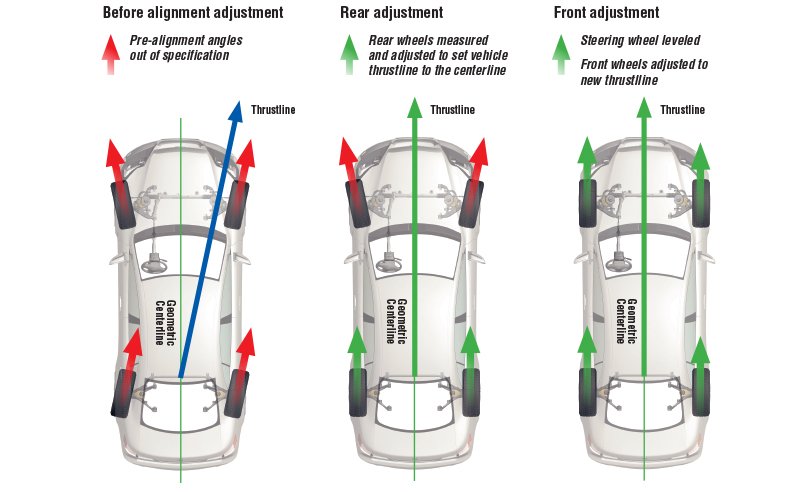
Importance of Wheel Alignment
When it comes to vehicle maintenance, things like oil changes and tire pressure checks often come to mind first. But what about wheel alignment? It might not seem as urgent, but overlooking it can lead to a cascade of problems, costing you money and potentially compromising your safety. Understanding the importance of wheel alignment is key to keeping your vehicle running smoothly and efficiently.

Think of alignment as your car’s posture. Just like good posture helps us move efficiently and prevents strain, proper wheel alignment ensures your tires meet the road at the correct angle, your wheels point straight ahead, and your vehicle travels smoothly. When this “posture” is off, things start to go wrong.
Let’s explore why maintaining correct wheel alignment is so crucial for every driver.
What Exactly is Wheel Alignment?
Wheel alignment, sometimes called tire alignment, doesn’t involve adjusting the tires or wheels themselves. Instead, it’s about adjusting the angles of the vehicle’s suspension system – the components that connect your vehicle to its wheels. The goal is to ensure the wheels are positioned correctly relative to each other and the road surface.
The main angles adjusted during an alignment are:
Camber: This is the inward or outward tilt of the top of the tire when viewed from the front. Too much inward (negative camber) or outward (positive camber) tilt causes uneven tire wear and can affect handling.
Toe: This refers to the direction your tires point (inward or outward) when viewed from above, similar to looking down at your own feet. “Toe-in” means the fronts of the tires point slightly inward; “toe-out” means they point outward. Incorrect toe is a primary cause of rapid tire wear.
Caster: This angle relates to the steering axis’s tilt when viewed from the side. Positive caster helps with steering stability and returnability (the wheel wanting to straighten out after a turn). While incorrect caster doesn’t typically cause tire wear, it significantly affects steering feel and stability.
Why is Proper Wheel Alignment So Important? The Benefits
Maintaining correct alignment offers significant advantages:
1. Maximizes Tire Lifespan
This is arguably the most significant financial benefit. Misalignment forces tires to scrub, drag, or wear unevenly across their surface. Correcting the alignment ensures the tires roll straight and make optimal contact with the road, leading to even wear and a much longer lifespan, saving you money on premature replacements.
2. Enhances Safety
Proper alignment is crucial for vehicle control. Misalignment can cause the vehicle to pull to one side, requiring constant steering correction from the driver. This can be tiring and dangerous, especially in emergency situations or poor weather conditions where precise control is vital. It ensures predictable handling and stability.
3. Improves Fuel Efficiency
When wheels aren’t aligned correctly, tires drag instead of rolling freely. This increased rolling resistance means your engine has to work harder to move the vehicle forward, consuming more fuel. Correct alignment minimizes this resistance, potentially leading to noticeable fuel savings over time.
4. Ensures Smoother Driving and Better Handling
A properly aligned vehicle drives straight without pulling, offers responsive steering, and generally feels more stable and comfortable to operate. The importance of wheel alignment is clearly felt in the driver’s seat through improved handling characteristics.
5. Reduces Wear on Suspension Components
Fighting against misaligned wheels puts extra stress on suspension and steering components like tie rods, ball joints, and bushings. Maintaining alignment helps reduce this strain, potentially extending the life of these expensive parts.
Signs Your Vehicle Needs an Alignment
How do you know if your alignment is off? Look out for these common symptoms:
Vehicle Pulling: The car drifts or pulls to the left or right when you try to drive straight.
Uneven Tire Wear: You notice tires wearing down much faster on the inside or outside edges.
Crooked Steering Wheel: The steering wheel isn’t centered when you’re driving straight.
Sloppy or Vibrating Steering: The steering feels loose, or you feel vibrations through the steering wheel.
Tire Squealing: Tires squeal during normal turns (not just aggressive cornering).
When Should You Get an Alignment Check?
It’s wise to have your alignment checked periodically, but definitely consider it when:
You get new tires (to protect your investment).
You’ve had suspension or steering components replaced.
You’ve hit a significant pothole, curb, or road debris.
You notice any of the warning signs listed above.
As part of regular maintenance – many recommend an annual check or every 10,000-12,000 miles (approx. 16,000-20,000 km).
Conclusion: Don’t Underestimate Alignment
The importance of wheel alignment cannot be overstated. It’s a fundamental aspect of vehicle maintenance that directly impacts tire longevity, fuel economy, handling, and most importantly, your safety on the road. While it might seem like an extra expense, the cost of regular alignment checks is minimal compared to the price of premature tire replacement, reduced fuel efficiency, and potential safety risks associated with misalignment. Keep your car driving straight and true – get your alignment checked regularly.
When was the last time you had your vehicle’s alignment checked? Share your thoughts or questions below!
